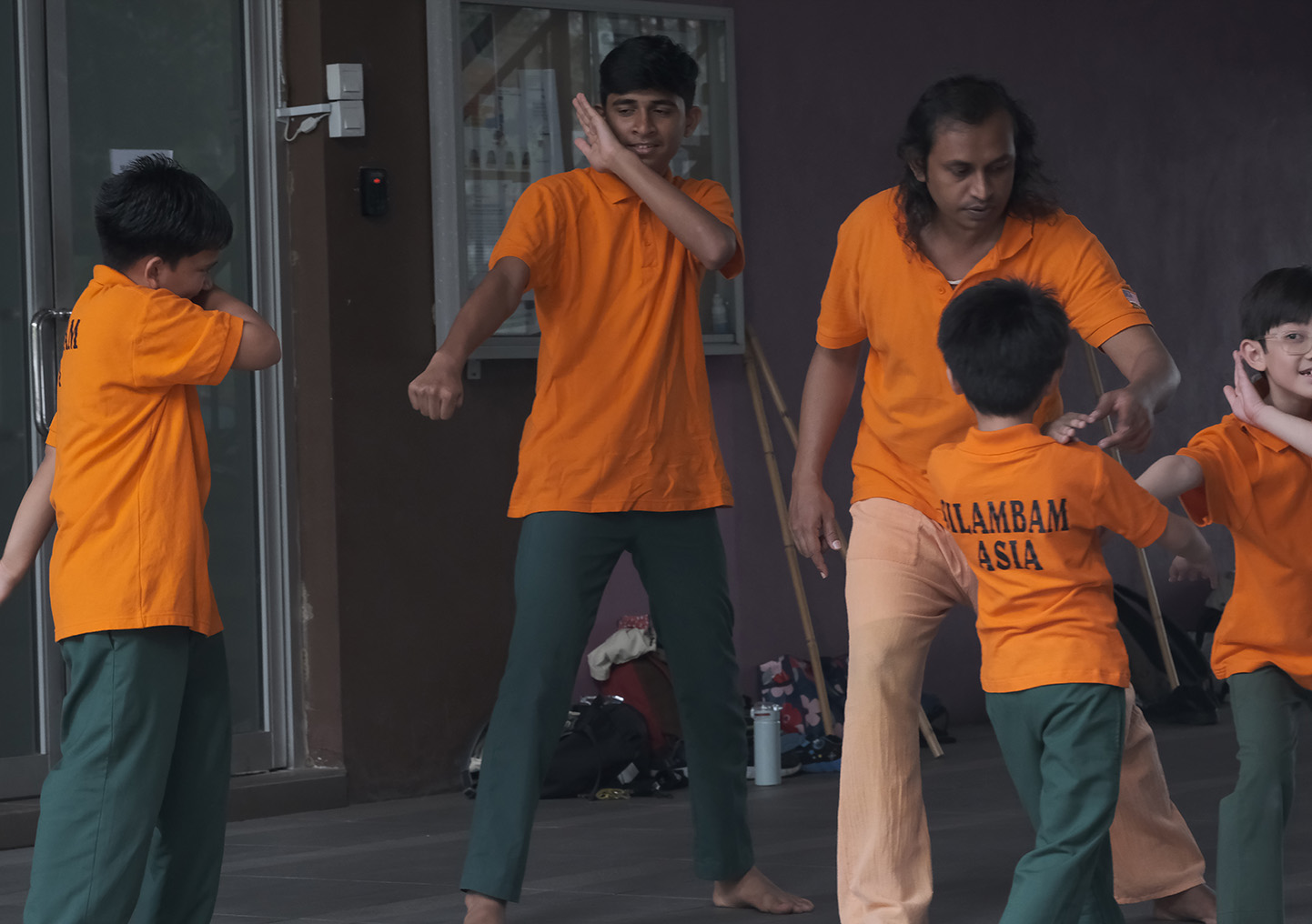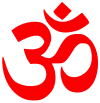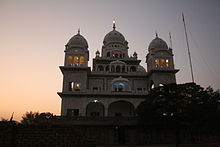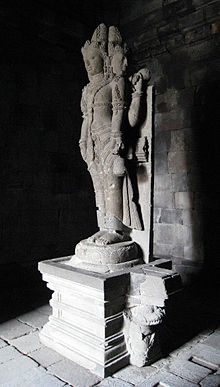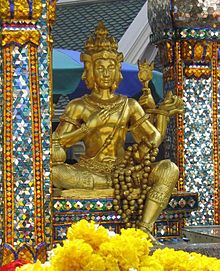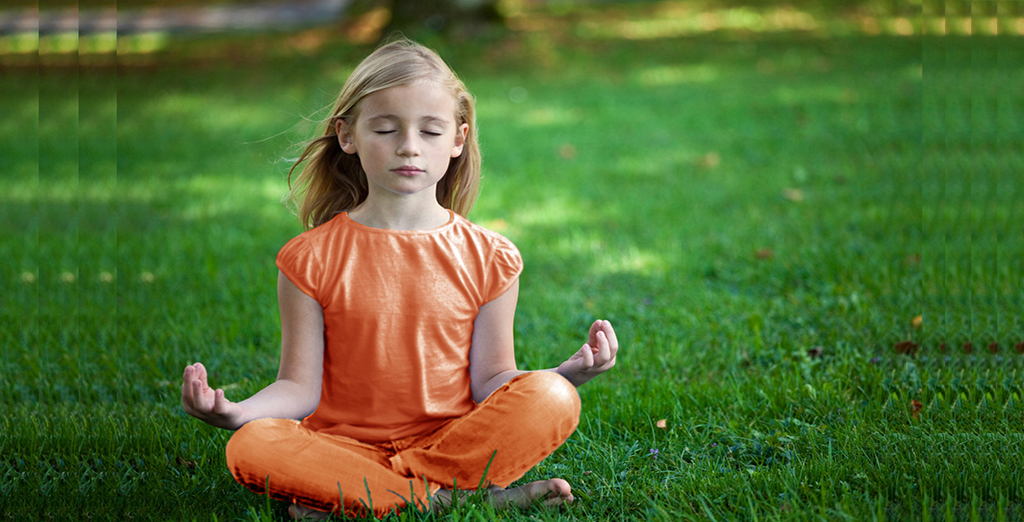|
|
Classification |
| Devanagari | no_data |
| Sanskrit Transliteration | no_data |
| Affiliation | no_data |
| Abode | no_data |
| Mantra | no_data |
| Weapon | no_data |
| Consort | no_data |
| Children | no_data |
| Mount | no_data |
| Brahma |
| The Creator of World & Vedas |
 |
| Devanagari |
ब्रह्मा |
| Sanskrit Transliteration |
Brahma |
| Affiliation |
Deva (Trimurti) |
| Abode |
Satyaloka (Brahmaloka), not to be confused with Brahmaloka-sanatana – abode of Brahman (Vishnu) |
| Mantra |
Om Brang Brahmaneya Namaha |
| Consort |
Saraswati, Brahmani, Gayatri |
| Mount |
Hansa (Swan or goose) |
Brahma (Sanskrit: ब्रह्मा; IAST: Brahma) is the Hindu god (deva) of creation and one of the Trimūrti, the others being Vishnu and Shiva. According to the Brahma Purana, he is the father of Manu, and from Manu all human beings are descended. In the Ramayana and the Mahabharata, he is often referred to as the progenitor or great grandsire of all human beings. He is not to be confused with the Supreme Cosmic Spirit in Hindu Vedanta philosophy known as Brahman, which is genderless. In Hindu tradition, the creation of Vedas is credited to Brahma. Brahma's wife is Saraswati. Saraswati is also known by names such as Savitri and Gayatri, and has taken different forms throughout history. Brahma is often identified with Prajapati, a Vedic deity. Being the husband of Saraswati or Vaac Devi (the Goddess of Speech), Brahma is also known as "Vaagish," meaning "Lord of Speech and Sound."
Etymology
In Sanskrit grammar, the noun stem brahman forms two distinct nouns; one is a neuter noun bráhman, whose nominative singular form is brahma ब्रह्म; this noun has a generalized and abstract meaning.
Contrasted to the neuter noun is the masculine noun brahmán, whose nominative singular form is Brahma ब्रह्मा. This noun is used to refer to a person, and as the proper name of a deity Brahma it is the subject matter of the present article.
Variations of the god's name include the following:
Origin
According to Shri Madha Bhagawata Mahapurana, Brahma was born through Vishnu's navel, Vishnu is the main source of whatsoever exists in the world; that is created by him of a part of his own body materials in this universe,;later he was wondered about the establishment of Mankind in the planet, hence at first he has created a lotus from his navel and from lotus Brahma origin. According to the Puranas, Brahma is self-born in the lotus (Nelumbo_nucifera) flower. Another legend says that Brahma was born in water, or from a seed that later became the golden egg. From this golden egg, Brahma, the creator was born, as Hiranyagarbha. The remaining materials of this golden egg expanded into the Brahmanḍa or Universe. Being born in water, Brahma is also called as Kanja (born in water). There is a story for Sharsa brahma hence the concept of multiple universe as every Brahma creates his Bhramand (universe) for one Brahma year.
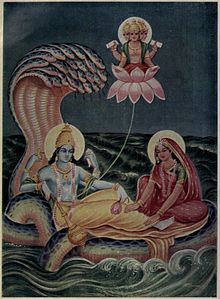
Vishnu with Lakshmi, on the serpent Ananta Shesha, as Brahma emerges from a lotus risen from Vishnu's navel
Creations
Head of Brahma in sandstone from the Phnom Bok in Bakheng style now in Guimet Museum in Paris.
At the beginning of the process of creation, Brahma creates the four Kumaras or the Catursana. However, they refuse his order to procreate and instead devote themselves to God
He then proceeds to create from his mind ten sons or Prajapatis (used in another[which? sense), who are believed to be the fathers of the human race. But since all these sons were born out of his mind rather than body, they are called Manas Putras or mind-sons or spirits. The Manusmŗti and Bhagavat Purana enumerate them as:
Brahma had ten sons and one daughter (Named Shatrupa- one who can take hundred forms) born from various parts of his body:
- Marichi
- Atri
- Angirasa
- Pulaha
- Pulasthya
- Krathu
- Vashista
- Prachethasa
- Bhrigu
- Narada
Within Vedic and Puranic scripture Brahma is described as only occasionally interfering in the affairs of the other devas (gods), and even more rarely in mortal affairs. He did force Soma to give Tara back to her husband, Bŗhaspati. Among the offspring from his body are Dharma and Adharma, Krodha, Lobha, and others.
Attributes
Appearance
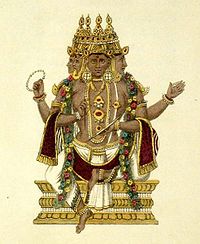
A handcoloured engraving of Brahma.
He is clad in red clothes. Brahma is traditionally depicted with four heads, four faces, and four arms. With each head, He continually recites one of the four Vedas. He is often depicted with a white beard (especially in North India), indicating the nearly eternal nature of his existence. Unlike most other Hindu gods, Brahma holds no weapons. One of his hands holds a scepter. Another of his hands holds a book. Brahma also holds a string of prayer beads called the 'akshamala' (literally "garland of eyes"), which He uses to keep track of the Universe's time. He is also shown holding the Vedas.
There are many other stories in the Puranas about the gradual decrease in Lord Brahma's importance. Followers of Hinduism believe that Humans cannot afford to lose the blessings of Brahma and Sarasvati, without whom the populace would lack creativity, knowledge to solve mankind's woes. There is a story of a fifth head. This head came when Shatrupa started flying away from him upwards and the head came on top of the four heads - symbolizing lust and ego. the head was decapitated by Shiva returning Brahma to his four head avatar which gave birth to the Vedas. The fifth head stayed with Shiva hence Shiva got the name Kapali.
symbols The Four Faces – The four Vedas (Rig, Sama, Yajur and Atharva).
The Four Hands – Brahma's four arms represent the four cardinal directions: east, south, west, and north. The back right hand represents mind, the back left hand represents intellect, the front right hand is ego, and the front left hand is self-confidence.
The Prayer beads – Symbolize the substances used in the process of creation.
The Book – The book symbolizes knowledge.
The Gold – Gold symbolizes activity; the golden face of Brahma indicates that He is actively involved in the process of creating the Universe.
The Swan – The swan is the symbol of grace and discernment. Brahma uses the swan as his vahana, or his carrier or vehicle.
The Crown – Lord Brahma's crown indicates His supreme authority.
The Lotus – The lotus symbolizes nature and the living essence of all things and beings in the Universe.
The Beard – Brahma's black or white beard denotes wisdom and the eternal process of creation.
Vehicle
Brahma's vehicle or vahana is the hansa, a swan or a goose.
Temples
Though almost all Hindu religious rites involve prayer to Brahma, very few temples are dedicated to His worship. Among the most prominent is the Brahma temple at Pushkar. Once a year, on Kartik Poornima, the full moon night of the Hindu lunar month of Kartik (October – November), a religious festival is held in Brahma's honour. Thousands of pilgrims come to bathe in the holy Pushkar Lake adjacent to the temple.
Temples to Brahma also exist in Thirunavaya in Kerala; in the temple town of Kumbakonam in the Thanjavur District of Tamil Nadu; in Kodumudi in Tamil Nadu; in Asotra village in Balotra taluka of Rajasthan's Barmer district which is known as Kheteshwar Brahmadham Tirtha. In the coastal state of Goa, a shrine belonging to 5th century AD, in the small and remote village of Carambolim in the Sattari Taluka in the northeast region of the state is found. Regular Pujas are held for Lord Brahma at the temple in Thirunavaya, and during Navrathris, this temple comes to life with multi-varied festivities. There is also a shrine for Brahma within the Brahmapureeswarar Temple in Thirukkadaiyur, and a famous murti of Brahma exists at Mangalwedha, 52 km from the Solapur district of Maharashtra. Statues of Brahma may be found in Khedbrahma, Gujarat, and in Sopara near Mumbai. There is a temple dedicated to Lord Brahma in the temple town of Sri Kalahasti near Tirupati in Andhra Pradesh. The Trimurti temple and the temple dedicated to Lord Brahma accompanied by Lord Ganesh, located outside Sri Padmanabhaswamy temple, in Thiruvananthapuram, Kerala, is also famous. The largest and most famous shrine to Lord Brahma may be found in Cambodia's Angkor Wat. 7 feet height of Chatrumukha(Four Faces ) BRAHMA temple at Bangalore(Karnataka, India).
In Java, Indonesia, the 9th century Prambanan Trimurti temple mainly is dedicated to Siva, however Brahma and Vishnu also venerated in separate large shrines inside the temple compound, a single large shrine dedicated to Brahma on southern side of Siva temple. There is a statue of Brahma at the Erawan Shrine in Bangkok. The golden dome of the Government House of Thailand also contains a statue of Phra Phrom (Thai representation of Brahma).
Temples devoted to Brahma
Today, India has very few temples dedicated to Brahma.
- Brahma Temple at Khokhan, in Kullu District [Himachal Pradesh]
- Brahma Temple at Asotra, District:Barmer in Rajasthan
- Brahma Temple at Oachira in Kollam district in the South Indian state of Kerala.
- Brahma temple at village aleo lord shrishty narayan, in kullu [himachal pradesh]
- Brahma Temple at Pushkar in Rajasthan
- Thirunavaya, Thiruvallam in Kerala
- Brahma Temple at Royakotta road in Hosur in Tamil Nadu
- Uttamar Kovil in Srirangam, Tamil Nadu
- Kumbakonam(Thanjavur District),Tamil Nadu
- Khedbrahma in Gujarat
- The Brahma Temple near Panajiin the village of Brahma-Carambolim in the Satari taluka of Goa
- The Lord Brahma (accompanied by Lord Ganesh) Temple, near the Sri Padmanabhaswamy temple, Thiruvananthapuram in Kerala
- Bramhapureeswarar temple in Tirupattur, near Trichy in Tamil Nadu
- Asotra in Rajasthan
- Chaturmukha Brahma temple in Chebrolu, Andhra Pradesh
- Chaturmukha (Four Faces) Brahma temple at Bangalore, Karnataka, India web: www.lordbrahma.in
Satyaloka – abode of Brahma
Satyaloka is by 120,000,000 yojanas above Tapoloka. Thus the distance from the Sun to Satyaloka is 233,800,000 yojanas, or 1,870,400,000 miles. The Vaikuntha planets begin 26,200,000 yojanas (209,600,000 miles) above Satyaloka. "In the Padma Puranam it has been definitely stated that on the four sides of the spiritual sky there are four different transcendental abodes occupied by Vasudeva, Sankarsana, Pradyumna and Aniruddha respectively. So also in the material sky also they are similarly placed on all the four sides. The Vaikuntha sphere which is covered with spiritual water is inhabited by Vasudeva and this Vaikuntha is known as Devavatipur. Above the Satyaloka there is Vishnuloka where Sankarsana resides. In the middle of the Ocean of Milk there is an island called Svetadvipa which is resided in by Aniruddha lying on the bed of Ananta."(Caitanya-caritamrta, Adi-lila, Chapter 5 [Handwritten])
Duration of day of Brahma
"Lord Brahma's day & night, each consists of his 14 hours or 4.32 billion human years. "Brahma has four heads" (Srimad Bhagavatam 12.8.2–5).
Brahma sampradaya
Brahma has his own sampradaya. Brahma appeared on a lotus flower which sprouted from the navel of Garbhodakshayi Vishnu. After meditation Brahma created 14 planetary systems and many living beings came there in 8400000 kinds of material bodies according to their past desires. Brahma received Vedas from Vishnu, and this Brahma-sampradaya is transmitting knowledge from Vishnu Himself to Earth. As our Brahma is devotee of Krishna just like other Brahmas in other material universes, we have this Brahma sampradaya.
Notes and references
| Data Arrangement, Technical Arrangement & Graphics |
|---|
| ♦ Guruji Murugan Chillayah - Silambam Asia |
| |
| References ( Brahma ) |
|---|
| ♦ no_data |
| ♦ no_data |
|
